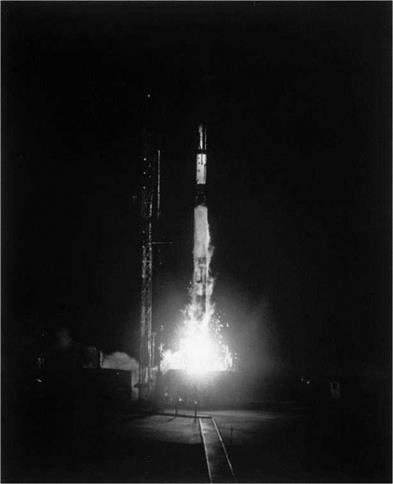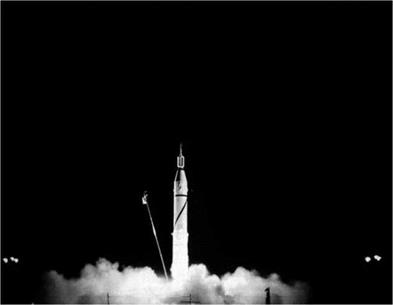Viking and Vanguard
28
Chapter 1 In the meantime, two other rocket programs had contributed to launch-vehicle technology. The Viking sounding rocket made its own contributions and was also, in a sense, the starting point for the second U. S. launch vehicle, Vanguard. Although often regarded
|
as a failure, Vanguard did launch three satellites. Together with Viking, it pioneered use of gimbals for steering in large rockets. In addition, its upper stages contributed significantly to the evolution of launch-vehicle technology.55
 Milton W. Rosen, who was responsible for the development and firing of the Viking rockets, went on to become technical director of Project Vanguard and then director of launch vehicles and propulsion in the Office of Manned Space Flight Programs for NASA. Rosen had been working at the Naval Research Laboratory (NRL) during World War II and suggested that his group implement an idea of G. Edward Pendray of the American Rocket Society to use rockets for exploration of the upper atmosphere. To prepare himself, he spent about eight months working at JPL in 1946-47. Drawing on what he learned there, some conversations with Wernher von Braun, and other sources, Rosen oversaw the design and testing of a totally new rocket, the Viking,56 another example of information sharing that contributed to rocket development.
Milton W. Rosen, who was responsible for the development and firing of the Viking rockets, went on to become technical director of Project Vanguard and then director of launch vehicles and propulsion in the Office of Manned Space Flight Programs for NASA. Rosen had been working at the Naval Research Laboratory (NRL) during World War II and suggested that his group implement an idea of G. Edward Pendray of the American Rocket Society to use rockets for exploration of the upper atmosphere. To prepare himself, he spent about eight months working at JPL in 1946-47. Drawing on what he learned there, some conversations with Wernher von Braun, and other sources, Rosen oversaw the design and testing of a totally new rocket, the Viking,56 another example of information sharing that contributed to rocket development.
Reaction Motors designed the engine, drawing on its own experience as well as data from the V-2, with the Glenn L. Martin Com-
pany designing and building the overall rocket. Martin engineers conceived Viking’s innovative gimballing engine. But to make it work, the Martin staff had to develop careful adjustments, using the advice of Albert C. Hall, who wrote his Ph. D. thesis at MIT on negative feedback. A successful program with 12 launches, Viking prepared Rosen and the Martin engineers for Vanguard.57
Developed under the auspices of the NRL to launch a satellite for the United States during the International Geophysical Year (July 1, 1957, to December 31, 1958), Vanguard became a NASA responsibility near the end of the project (on November 30, 1958). NRL appointed astronomer John Hagen as overall director, with Rosen becoming technical director. The navy contracted with Martin on September 23, 1955, to design, build, and test Vanguard in preparation for flight. Martin, in turn, contracted with GE on October 1, 1955, to develop the first-stage engine and with Aerojet on November 14, 1955, for the second-stage engine. There were two contracts for alternative versions of a stage-three solid-propellant motor. One in February 1956 went to the Grand Central Rocket Company, with a second going to the Allegany Ballistics Laboratory (ABL), operated by the Hercules Powder Company, Inc., in West Virginia.58
Hampered by a low priority, which caused Martin to split up the experienced Viking team between it and the higher-priority Titan I missile (for which Martin had also contracted), Rosen and his Vanguard engineers had other difficulties, including substantially new technology for all three stages. Contributions from a wide variety of organizations were necessary to develop the three stages. Problems with the first – and second-stage engines caused delays in development and testing; Sputnik and the cold-war desire to catch up with the Soviets led to unexpected publicity for the first test launch, in which both the problematical second stage and the complete guidance/control system were operational. Although three previous tests had been successful, this attempted launch with a small satellite onboard was a spectacular failure. The press did not react charitably but called the vehicle “Kaputnik, Stayputnik, or Flopnik" while Americans, in one historian’s words, “swilled the Sputnik Cocktail: two parts vodka, one part sour grapes."59
Between March 17, 1958, and September 18, 1959, Vanguard launch vehicles orbited three satellites in nine attempts, the last 30 of which used the solid third stage developed at ABL. This hardly Chapter 1 constituted a successful record, but Vanguard nevertheless made important technological contributions. The air force’s Thor-Able launch vehicle used the Thor intermediate-range ballistic missile as a first stage plus modified Vanguard second and third stages, the last
|

being the original third stage developed by Grand Central Rocket Company. The air force also learned from the problems Vanguard had experienced and thereby avoided them, illustrating a transfer of information from a navy project to a competing military service. Despite interservice rivalries, the federal government encouraged this sort of transfer, limiting the rights of individual contractors to protect discoveries made under federal contract in order to facilitate technology transfer. But the emphasis in the literature on competition rather than cooperation often masks the importance of transferred data.
 In January 1959, Rosen proposed to Abe Silverstein, NASA’s director of Space Flight Programs, that the Thor-Able be evolved into what became the Delta launch vehicle. Rosen suggested designing
In January 1959, Rosen proposed to Abe Silverstein, NASA’s director of Space Flight Programs, that the Thor-Able be evolved into what became the Delta launch vehicle. Rosen suggested designing
more reliable control electronics than used on Vanguard, substitution of a stainless-steel combustion chamber for the aluminum one used in the second stage of Vanguard, and incorporation of Bell Telephone Laboratories’ radio guidance system then being installed in the Titan ballistic missile, among other changes. Silverstein commissioned Rosen to develop the Delta launch vehicle along those lines, and it became highly successful. A variant of the ABL third stage for Vanguard, known as the Altair I (X248 A5), became a third stage for Delta and a fourth stage for the Scout launch vehicle. A follow-on, also built by Hercules Powder Company (at ABL), became the third stage for Minuteman I. And a fiberglass casing for the ABL third stage was also a feature in these later stages and found many other uses in missiles and rockets. In these and other ways, Vanguard made important contributions to launch-vehicle technology and deserves a better reputation than it has heretofore enjoyed.60











